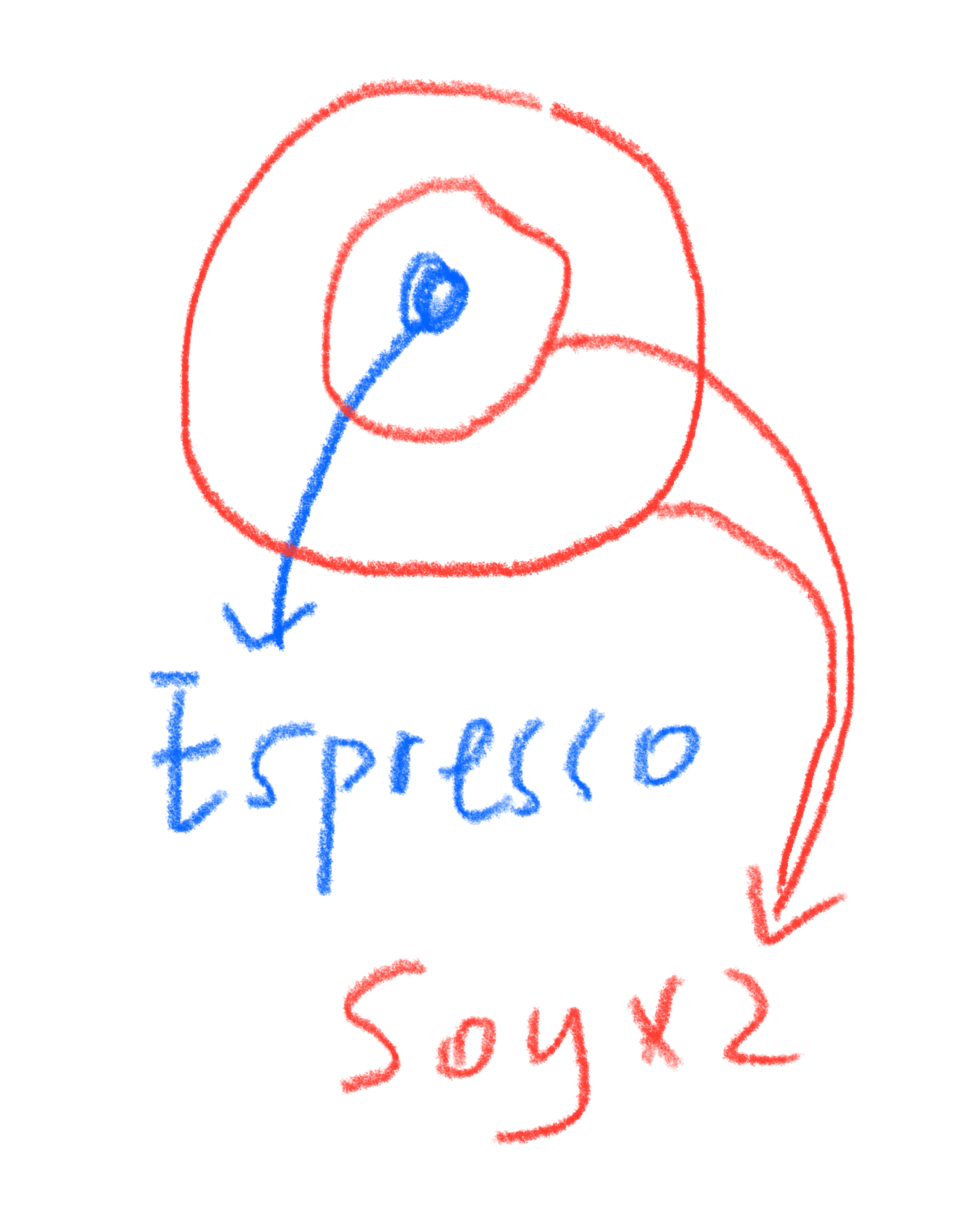装饰者模式可以在不修改代码和不创建新的子类的情况下,动态地为对象扩展功能。
问题场景
假设我们开了一家咖啡店。
假设这家店是星巴克,它拥有一个饮料超类,名为 Beverage。所有咖啡子类都继承自这个饮料超类。饮料超类主要有两个成员函数:
1
2
3
4
5
6
7
8
9
class Beverage{ // 抽象类
constructor(){
this.description = "default";
}
getDescription(){
return this.description;
}
cost(){ /* 由子类实现 */}
}
我们举一个咖啡子类 Mocha 作为例子:
1
2
3
4
5
6
7
8
class Mocha extends Beverage{
constructor(){
this.description = "Mocha";
}
cost(){
return 1.99;
}
}
问题1:类数量爆炸
星巴克并不只有一种摩卡咖啡,它还有双倍牛奶浓缩咖啡、抹茶星冰乐、蜂蜜红茶等等等等。
所有这些不同种类的咖啡,都需要继承自 Beverage。这样的话,最终的类图就会变得非常庞大。况且,假设顾客只想点一杯加三倍蜂蜜的摩卡咖啡,我们该如何实现这个需求呢?继续继承 Beverage,创建一个新的“三倍蜂蜜摩卡”子类吗?
问题2:解决问题 1 的同时引出问题 2
咖啡店中的新种类咖啡,其实都是在饮料基础上加上各种调料,例如蜂蜜、牛奶等等。我们可以将这些调料单独抽象出来,只留下几个以饮料基底命名的基础类,然后在基础类之上改变各种调料变量,组合成不同的饮料,就能解决类数量爆炸的问题(这个思想有点类似于策略模式)。那么,这个该如何在代码中实现呢?
很容易想到,在超类 Beverage 中添加 setter 函数(e.g. setMilk())。当加入调料后,价格也应当相应地变化。我们再添加 hasOrNot 函数(e.g. hasMilk()),用于判断饮料中是否加入了某种调料:
1
2
3
4
5
6
7
8
9
10
11
12
13
14
15
16
17
18
19
20
21
class Beverage{
constructor(){
// ...
this.hasMilk = false;
this.hasHoney = false;
// ...
}
// ...
setMilk(){}
hasMilk(){}
setHoney(){}
hasHoney(){}
// ...
cost(){
let x = 1.99;
if (this.hasMilk()) x += 0.5;
else if (this.hasHoney()) x += 0.6;
// else if ...
return x;
}
}
看上去似乎没问题?
但是,如果出现了新需求,比如现在我们需要调整调料价格、增加新的调料或删除旧的调料,就需要对超类代码进行大量修改,包括更改cost函数、更改构造函数、添加或删除setter和has函数等。
另外,如果星巴克新增一种酒精饮料,该饮料不能加入蜂蜜或牛奶,那么将出现类似于策略模式的问题,因为子类必然继承超类的成员函数。
参考视频 中的讲解者认为,HF 教材的星巴克例子很适合讲解装饰者模式,但却不是装饰者模式的 best use case。就是说,解决以上咖啡店例子问题的最佳设计模式其实不是装饰者模式。
我大概能 get 到他的意思。对我来说诡异的点是:饮料调料的类「继承」自饮料超类。调料又不是一种饮料对吧?但它却继承自饮料超类,well…… 符合直觉的做法是额外创造一个调料超类,然后「组合」调料超类的各种子类+饮料超类的各种子类来搭配出新的饮料。
代码实现
让我们先来看一下装饰者模式的类图(截取自参考视频):

装饰者模式的核心:装饰者类既是(is-A) Beverage 超类的子类,又拥有(has-A)一个 Beverage 超类的另外子类的实例。
什么叫既是 is-a 又是 has-a?例如,在以下代码中,我们定义了一个调料装饰者抽象类,它继承自 Beverage 超类,同时拥有一个 Beverage 类型的实例变量 beverage:
1
2
3
4
5
6
7
8
9
10
// 饮料超类
class Beverage{/* ... */}
// 调料装饰者类
class AddonDecorator extends Beverage{ // is-a
constructor(){
super();
this.beverage = null; // has-a
}
}
现在,让我们来看一下如何将调料(装饰者)添加到饮料(被装饰者)中。
首先是以上类图的完整实现,定义我们的“菜单”:
1
2
3
4
5
6
7
8
9
10
11
12
13
14
15
16
17
18
19
20
21
22
23
24
25
26
27
28
29
30
31
32
33
34
35
36
37
38
39
40
41
42
43
44
45
46
47
48
49
50
51
52
53
54
55
56
57
58
59
60
61
62
63
64
65
66
class Beverage {
// 抽象类
constructor() {
this.description = 'default';
}
getDescription() {
return this.description;
}
cost() {/* 由子类实现 */}
}
class Decaf extends Beverage {
constructor() {
super();
this.description = 'Decaf';
}
cost() {
return 0.99;
}
}
class Espresso extends Beverage {
constructor() {
super();
this.description = 'Espresso';
}
cost() {
return 1.99;
}
}
// 调料装饰者抽象类
class AddonDecorator extends Beverage {
constructor() {
super();
this.beverage = null;
this.description = '';
}
getDescription() {
// watch out: here starts wrap
return this.beverage.getDescription() + ', ' + this.description;
}
cost() {}
}
class Soy extends AddonDecorator {
constructor(beverage) {
super();
this.beverage = beverage;
this.description = 'soy';
}
cost() {
return this.beverage.cost() + 0.5;
}
}
class Caramel extends AddonDecorator {
constructor(beverage) {
super();
this.beverage = beverage;
this.description = 'caramel';
}
cost() {
return this.beverage.cost() + 0.3;
}
}
接下来,让我们来看一下如何将调料(装饰者)添加到饮料(被装饰者)中。我们如何获得「双倍 Soy 的 Espresso」饮料呢?

1
2
3
4
5
6
7
8
9
10
11
12
// 首先,创建一个饮料基底 espresso
let ourCoffee = new Espresso();
// 接下来,添加一份 soy 调料
ourCoffee = new Soy(ourCoffee); // 包装
// 再添加一份 soy 调料
ourCoffee = new Soy(ourCoffee); // 再次包装
// 现在,检查一下我们的饮料构成:
ourCoffee.getDescription(); // Espresso, soy, soy
// 最后,计算价格:
ourCoffee.cost(); // 2.99
以上是整个系统的代码实现。现在,我们可以根据需要添加不同的饮料和调料,从而创建出无数种不同的饮料组合。
优缺点
优点:
- 满足开闭原则。不需修改已有代码,灵活地扩展功能;
- 将功能分解成更小、更具体的类,使得类的职责更加单一,更容易维护和扩展;
- 在运行时能灵活地增减功能,通过组合不同的装饰者,可以创造出大量不同行为的组合。
缺点:
- 由于装饰者模式功能过度分解、分解得过于细致,可能导致代码过于复杂化;
- 同样由于较多的细小的类,会导致方法调用和对象创建较为复杂,降低系统的运行效率。
现实应用
- 用户图形交互界面。用装饰者模式为各种 UI 添加新特性,比如改变边界样式或颜色。
- 输入/输出流。Java 的输入输出流使用装饰者模式控制。为基础的输入输出加入缓冲池(一个 bit 一个 bit 地读写 -> 缓冲池满后再统一读写,减少读写次数)或数据压缩功能。
- 日志记录。在日志基础信息之上,添加时间戳或者额外的日志信息。
- 加密系统。在已有加密系统上多增加一层加密层。
- 网络服务器。 Express 应用里创建 http server 和利用 Socket.IO 初始化 WebSocket 协议:
1
2
3
4
5
6
7
8
9
// 首先, 获得基础服务器 http server
let { httpServer } = require('http');
// 然后,加上 Websocket 协议
const { Server } = require('socket-io');
let socket = new Server(httpServer, options);
// 最后,开启 http server 监听
httpServer.listen(3000);
参考资料
- Youtube: decorator pattern
- 《Head First 设计模式》第三章